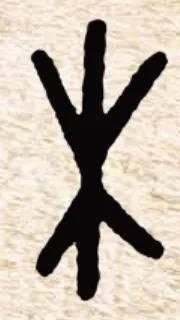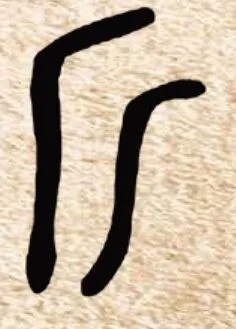析xī
As one of the great inventions of China,Chinese characters are the gems of China’s splendid culture.Their unique artistic charm has held the attention of Chinese people in different times and has been adored by many.Chinese characters each have their own lively structures and forms,each of which tells an interesting and amazing story.When we talk about the charms of Chinese characters,the word 析(xī) comes to my mind,and we are amazed by its interesting structure and form,as well as the story behind its formation.
The Chinese character 析composed of eight strokes is a verb in Chinese.It means dividing,separating,analyzing,or dissecting.As to its structure,the character 析 consists of two parts.The left part is 木(mù),which denotes tree,timber,or wood; the right part is 斤(jīn),which is a unit of weight.1 jīn is equal to 500 grams,which is commonly used in our daily life to tell the weight of things.1 jīn used to be equal to 16 兩(liǎng) in the old system of weight,and changed to be equal to 10 liǎng later.
You Qiaorong,PhD in literature,professor at School of Foreign Languages,Central China Normal University.Professor You’s research fields include British and American literature,college English teaching,Chinese and Western culture.
As a combination of the two Chinese characters 木and 斤 with completely different meanings,析 has been an interesting puzzle to modern Chinese scholars.In fact,there is an interesting story behind its formation.In the ancient times,the original meaning of the character 析 was felling a tree with axe,which is also its earliest meaning.Its extended meaning used today evolved from its ancient original meaning.

Studies indicate that the left part 木of the character 析 is the regular script that progressively evolved from its ancient pictogram.Chinese pictograms convey their meanings through their pictorial resemblance to the physical objects they signify.The early pictographic form of 木 is a simple drawing that describes the physical appearance of a tree.The oracle bone script of 木looks like a tree.On its upper part are tree branches spreading upward.The lower part looks like its roots buried underground.The middle part is the trunk of the tree.The original meaning of 木 is tree,and it’s still so used in today’s Chinese.
斤,the right part of 析,also evolved from its ancient pictogram.Though now it is a unit of weight,in the ancient times,its early pictographic form resembled an axe used for felling trees.The oracle bone script of 斤 looks like an axe.Its top part is a transverse knife with its sharp tip pointing to the left side and the part under the right end of the knife is a fairly long handle that is not straight.It describes the physical appearance of an axe.
The present regular script斤 is the version that evolved from the ancient script.But how did it evolve this way? Some scholars believe that after the ancient people made an axe,they often worked out the weight of the axe,so it had the extended meaning of signifying the weight of things.Still other people hold that the ancient people didn’t have characters representing weight units,and that the smart ancestors borrowed the character斤 to represent weight.Despite that,without a doubt,the early original meaning of 斤 is axe.
The character 析is the regular script as a result of gradual evolvement from its ancient pictogram.析is a combination of 木 and 斤,so the ancient oracle bone script of 析looks like a tree with an axe on its right side.It draws a vivid picture presenting a scene in which our ancestor was wielding an axe to cut down a tree.It is a kind of record of a working activity of the ancient people.
Since the ancient version of 析has the meaning of separating a tree into two parts by cutting,later it extended its meaning into dividing,separating,analyzing,or dissecting.For instance,in the phrase 解析(jiěxī),we use it to mean dividing (a mixture) into separate parts,or studying something very carefully part by part.And to 分析(fēnxī,analyze) a sentence means dividing a sentence into various parts to figure out the syntactic structure of the sentence.Obviously,there is no denying that the extended meaning of the character 析 we use today is based on its ancient original meaning.

The oracle bone script of 木looks like a tree

The oracle bone script of 斤looks like an axe


